| dc.contributor.author | Patriarca, Riccardo | |
| dc.contributor.author | Falegnami, Andrea | |
| dc.contributor.author | De Nicola, Antonio | |
| dc.contributor.author | Villani, Maria Luisa | |
| dc.contributor.author | Paltrinieri, Nicola | |
| dc.date.accessioned | 2019-08-07T13:22:48Z | |
| dc.date.available | 2019-08-07T13:22:48Z | |
| dc.date.created | 2019-07-26T13:44:18Z | |
| dc.date.issued | 2019 | |
| dc.identifier.issn | 0925-7535 | |
| dc.identifier.uri | http://hdl.handle.net/11250/2607483 | |
| dc.description.abstract | The development of safety indicators represents an integral part of any safety management process. Safety indicators are generally classified as leading or lagging, respectively whether they are active (providing feedback on performance before an accident or incident), or reactive measurements (identifying and reporting on incidents to identify weaknesses and failures). Leading indicators have been largely addressed as early warning instruments crucial to assess the potential for either safety events (accidents, incidents), or system’s resilience. The Resilience-based Early Warning Indicator (REWI) method is a representative approach to develop such indicators. However, its main challenges are related to the data gathering process, which is traditionally managed by open-ended interviews or surveys, and the fact that the developed indicators may not necessarily represent proxy measures of system performance. This paper presents an alternative methodological framework for the development of leading indicators. We will explore the use of GREWI (Games for Resilience-based Early Warning Indicator method), a new method based on gamified data gathering, more specifically related to serious games. Abandoning traditional tick-box surveys, the proposed approach is intended to favour workers’ engagement in workplace safety and, more in general, to overcome psychological barriers to their participation. The approach has been explored in a case study within chemical industry. In particular, the safety-critical sector of ammonia production has been addressed, with the purpose to promote and improve its resilience towards unwanted events. | nb_NO |
| dc.language.iso | eng | nb_NO |
| dc.publisher | Elsevier | nb_NO |
| dc.rights | Attribution-NonCommercial-NoDerivatives 4.0 Internasjonal | * |
| dc.rights.uri | http://creativecommons.org/licenses/by-nc-nd/4.0/deed.no | * |
| dc.title | Serious games for industrial safety: An approach for developing resilience early warning indicators | nb_NO |
| dc.type | Journal article | nb_NO |
| dc.type | Peer reviewed | nb_NO |
| dc.description.version | acceptedVersion | nb_NO |
| dc.source.journal | Safety Science | nb_NO |
| dc.identifier.doi | 10.1016/j.ssci.2019.05.031 | |
| dc.identifier.cristin | 1712898 | |
| dc.description.localcode | © 2019. This is the authors’ accepted and refereed manuscript to the article. Locked until 25.5.2022 due to copyright restrictions. This manuscript version is made available under the CC-BY-NC-ND 4.0 license http://creativecommons.org/licenses/by-nc-nd/4.0/ | nb_NO |
| cristin.unitcode | 194,64,92,0 | |
| cristin.unitname | Institutt for maskinteknikk og produksjon | |
| cristin.ispublished | true | |
| cristin.fulltext | postprint | |
| cristin.qualitycode | 1 | |

